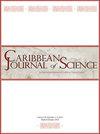波多黎各La Parguera的钙质海绵中的相关生物
IF 0.5
4区 生物学
Q4 BIODIVERSITY CONSERVATION
引用次数: 5
摘要
摘要海绵为加勒比珊瑚礁提供了一系列生态服务和好处。它们是各种令人困惑的物种的栖息地,然而,对Calcarea类海绵相关动物的系统学和分布或加勒比海海绵的关注有限。这项研究的目的是描述波多黎各La Parguera自然保护区多个珊瑚礁上钙质海绵木犀属的群落特征。43个木犀标本的相关动物群共产生2249个相关的群落,分布在7个无脊椎动物门中。节肢动物门是最丰富的门,占总丰度的62.5%,其次是环节动物门(21.0%)和线虫门(5.5%)。由于该物种的隐蔽性为本次调查提供了机会采样,因此推测时间或空间变异模式有限。我们的数据集与Demospongiae类的数据集一致,最丰富的相关动物群是桡足类和多毛类。然而,与其他Calcarea相比,本研究发现了更多的相关动物群。本文章由计算机程序翻译,如有差异,请以英文原文为准。
Associated organisms inhabiting the calcareous sponge Clathrina lutea in La Parguera, Puerto Rico
Abstract. Sponges provide an array of ecological services and benefits for Caribbean coral reefs. They function as habitats for a bewildering variety of species, however limited attention has been paid in the systematics and distribution of sponge-associated fauna in the class Calcarea or for that matter of sponges in the Caribbean. The goal of this study was to characterize infaunal assemblages from a calcareous sponge, Clathrina lutea, across multiple reefs from the La Parguera Natural Reserve, Puerto Rico. The associated fauna from 43 C. lutea specimens yielded a total of 2,249 associated infauna distributed in seven invertebrate phyla. Arthropoda was the most abundant phylum accounting for 62.5% of total abundance, followed by Annelida (21.0%) and Nematoda (5.5%). Limited patterns of temporal or spatial variability were surmised due to the opportunistic sampling effort afforded to this investigation from the cryptic nature of this species. A concordance between our data set and those for the class Demospongiae were observed, with the most abundant associated fauna being copepods and polychaetes. However, when compared to other Calcarea, the present study found considerably more associated fauna.
求助全文
通过发布文献求助,成功后即可免费获取论文全文。
去求助
来源期刊

Caribbean Journal of Science
综合性期刊-生物多样性保护
CiteScore
1.00
自引率
25.00%
发文量
21
审稿时长
>12 weeks
期刊介绍:
The Caribbean Journal of Science publishes articles, research notes, and book reviews pertinent to natural science of the Caribbean region. The emphasis is on botany, zoology, ecology, conservation biology and management, geology, archaeology, and paleontology. The mission as a nonprofit scholarly journal is to publish quality, peer-reviewed papers and to make them widely available.
 求助内容:
求助内容: 应助结果提醒方式:
应助结果提醒方式:


